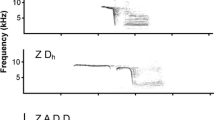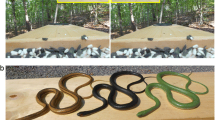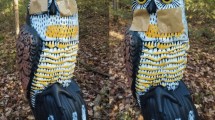Abstract
Although anti-predator behavior systems have been studied in diverse taxa, less is known about how prey species detect and assess the immediate threat posed by a predator based on its behavior. In this study, we evaluated a potential cue that some species may utilize when assessing predation threat—the predator’s body and head orientation. We tested the effect of this orientation cue on signaling and predation-risk-sensitive foraging of a prey species, tufted titmice (Baeolophus bicolor). Earlier work revealed sensitivity of titmice and related species to the presence of predator stimuli. Here, we manipulated cat models to face either toward or away from a food source preferred by titmice and then measured titmouse calling and seed-taking behavior. Titmice showed greater feeder avoidance when the cat predator models faced the feeder, compared to when the models faced away from the feeder or when titmice were exposed to control stimuli. Titmouse calling was also sensitive to predator head/body orientation, depending upon whether titmice were from sites where real cats had been observed or not. This study experimentally demonstrated that both calling and foraging of prey species can be affected by the head and body orientation of an important terrestrial predator. Prey species may therefore signal in strategic ways to conspecifics not just about predator presence, but also urgency of threat related to the more subtle cue of the head and body orientation of the predator. These findings hold potential implications for understanding animal cognition and learning processes.



Similar content being viewed by others
References
Baker PJ, Bentley AJ, Ansell RJ, Harris S (2005) Impact of predation by domestic cats Felis catus in an urban area. Mamm Rev 35:302–312
Bartmess-LeVasseur J, Branch CL, Browning SA, Owens JL, Freeberg TM (2010) Predator stimuli and calling behavior of Carolina chickadees (Poecile carolinensis), tufted titmice (Baeolophus bicolor), and white-breasted nuthatches (Sitta carolinensis). Behav Ecol Sociobiol 64:1187–1198
Bateman P, Fleming P (2011) Who are you looking at? Hadeda ibises use direction of gaze, head orientation and approach speed in their risk assessment of a potential predator. J Zool 285:316–323
Beckerman A, Boots M, Gaston K (2007) Urban bird declines and the fear of cats. Anim Conserv 10:320–325
Blumstein DT, Daniel JC (2002) Isolation from mammalian predators differentially affects two congeners. Behav Ecol 13:657–663
Branch CL, Freeberg TM (2012) Distress calls in tufted titmice (Baeolophus bicolor): are conspecifics or predators the target? Behav Ecol 23:854–862
Burger J, Gochfeld M (1981) Discrimination of the threat of direct versus tangential approach to the nest by incubating herring and great black-backed gulls. J Comp Physiol Psychol 95:676–684
Burger J, Gochfeld M, Murray BG (1992) Risk discrimination of eye contact and directness of approach in black iguanas (Ctenosaura similis). J Comp Psychol 106:97–101
Burghardt GM (1985) Animal awareness: current perceptions and historical perspective. Am Psychol 40:905–919
Caro T (2005) Antipredator defenses in birds and mammals. University of Chicago Press, Chicago
Carter J, Lyons NJ, Cole HL, Goldsmith AR (2008) Subtle cues of predation risk: starlings respond to a predator’s direction of eye-gaze. Proc R Soc B 275:1709–1715
Churcher P, Lawton J (1987) Predation by domestic cats in an English village. J Zool 212:439–455
Clucas B, Marzluff JM, Mackovjak D, Palmquist I (2013) Do American crows pay attention to human gaze and facial expressions? Ethology 119:296–302
Cooper WE (1998) Direction of predator turning, a neglected cue to predation risk. Behaviour 135:55–64
Cooper WE Jr (2003) Risk factors affecting escape behavior by the desert iguana, Dipsosaurus dorsalis: speed and directness of predator approach, degree of cover, direction of turning by a predator, and temperature. Can J Zool 81:979–984
Courter JR, Ritchison G (2010) Alarm calls of tufted titmice convey information about predator size and threat. Behav Ecol 21:936–942
Curio E (1993) Proximate and developmental aspects of antipredator behavior. Adv Study Behav 22:135–238
Curio E, Ernst U, Vieth W (1978) The adaptive significance of avian mobbing. Zeit für Tierpsychol 48:184–202
Freeberg TM, Krama T, Vrublevska J, Krams I, Kullberg C (2014) Tufted titmouse (Baeolophus bicolor) calling and risk-sensitive foraging in the face of threat. Anim Cogn 17:1341–1352
Gillies C, Clout M (2003) The prey of domestic cats (Felis catus) in two suburbs of Auckland City, New Zealand. J Zool 259:309–315
Griesser M (2008) Referential calls signal predator behavior in a group-living bird species. Curr Biol 18:69–73
Grubb TC, Pravosudov VV (1994) Tufted titmouse (Baeolophus bicolor). In: Poole A, Gill F (eds) The birds of North America, No. 86. The Academy of Natural Sciences, Philadelphia PA; The American Ornithologists’ Union, Washington, DC, pp 1–16
Krama T, Krams I (2005) Cost of mobbing call to breeding pied flycatcher, Ficedula hypoleuca. Behav Ecol 16:37–40
Krams I, Krama T, Freeberg TM, Kullberg C, Lucas JR (2012) Linking social complexity and vocal complexity: a parid perspective. Philos Trans R Soc B 367:1879–1891
Leavesley AJ, Magrath RD (2005) Communicating about danger: urgency alarm calling in a bird. Anim Behav 70:365–373
Lee WY, Lee S, Choe JC, Jablonski PG (2011) Wild birds recognize individual humans: experiments on magpies, Pica pica. Anim Cogn 14:817–825
Lepczyk CA, Mertig AG, Liu J (2004) Landowners and cat predation across rural-to-urban landscapes. Biol Conserv 115:191–201
Licht T (1989) Discriminating between hungry and satiated predators: the response of guppies (Poecilia reticulata) from high and low predation sites. Ethology 82:238–243
Lima SL (1987) Clutch size in birds: a predation perspective. Ecology 68:1062–1070
Lima SL (1998) Stress and decision-making under the risk of predation: recent developments from behavioral, reproductive, and ecological perspectives. Adv Study Behav 27:215–290
Lima SL (2002) Putting predators back into behavioral predator–prey interactions. Trends Ecol Evol 17:70–75
Lima SL (2009) Predators and the breeding bird: behavioral and reproductive flexibility under the risk of predation. Biol Rev 84:485–513
Lucas JR, Freeberg TM (2007) Information and the chick-a-dee call: communicating with a complex vocal system. In: Otter KA (ed) Ecology and behavior of chickadees and titmice. Oxford University Press, Oxford, pp 199–213
Magurran AE (2005) Evolutionary ecology: the Trinidadian guppy. Oxford University Press, Oxford
Maloney RF, McLean IG (1995) Historical and experimental learned predator recognition in free-living New-Zealand robins. Anim Behav 50:1193–1201
Marzluff JM, Walls J, Cornell HN, Withey JC, Craig DP (2010) Lasting recognition of threatening people by wild American crows. Anim Behav 79:699–707
Owens JL, Freeberg TM (2007) Variation in chick-a-dee calls of tufted titmice, Baeolophus bicolor: note type and individual distinctiveness. J Acoust Soc Am 122:1216–1226
Papworth S, Milner-Gulland E, Slocombe K (2013) Hunted woolly monkeys (Lagothrix poeppigii) show threat-sensitive responses to human presence. PLoS ONE 8:e62000
Pravosudov V, Grubb T (1998) Management of fat reserves in tufted titmice Baelophus bicolor in relation to risk of predation. Anim Behav 56:49–54
Preisser EL, Bolnick DI, Benard MF (2005) Scared to death? The effects of intimidation and consumption in predator–prey interactions. Ecology 86:501–509
Rosa Salva O, Regolin L, Vallortigara G (2007) Chicks discriminate human gaze with their right hemisphere. Behav Brain Res 177:15–21
Sieving KE, Hetrick SA, Avery ML (2010) The versatility of graded acoustic measures in classification of predation threats by the tufted titmouse Baeolophus bicolor: exploring a mixed framework for threat communication. Oikos 119:264–276
Soard CM, Ritchison G (2009) ‘Chick-a-dee’calls of Carolina chickadees convey information about degree of threat posed by avian predators. Anim Behav 78:1447–1453
Templeton CN, Greene E, Davis K (2005) Allometry of alarm calls: black-capped chickadees encode information about predator size. Science 308:1934–1937
van Heezik Y, Smyth A, Adams A, Gordon J (2010) Do domestic cats impose an unsustainable harvest on urban bird populations? Biol Conserv 143:121–130
Watve M, Thakar J, Kale A, Puntambekar S, Shaikh I, Vaze K, Jog M, Paranjape S (2002) Bee-eaters (Merops orientalis) respond to what a predator can see. Anim Cogn 5:253–259
Woods M, McDonald RA, Harris S (2003) Predation of wildlife by domestic cats Felis catus in Great Britain. Mammal Rev 33:174–188
Yorzinski JL, Patricelli GL (2010) Birds adjust acoustic directionality to beam their antipredator calls to predators and conspecifics. Proc R Soc B 277:923–932
Zachau CE, Freeberg TM (2012) Chick-a-dee call variation in the context of “flying” avian predator stimuli: a field study of Carolina chickadees (Poecile carolinensis). Behav Ecol Sociobiol 66:683–690
Zuberbühler K, Noë R, Seyfarth RM (1997) Diana monkey long-distance calls: messages for conspecifics and predators. Anim Behav 53:589–604
Acknowledgments
We thank Rebecca Weiner for assistance with data collection in this study. Thanks to the staff of the Ijams Nature Center, Norris Dam State Park, and the University of Tennessee Forest Resources, Research, and Education Center for allowing us to carry out these studies. We are grateful to Sheri Browning, Gordon Burghardt, Brittany Coppinger, Elizabeth Hobson, Amiyaal Ilany, Rosalee Kaschel, Arik Kershenbaum, Indriķis Krams, Steven Kyle, and two anonymous reviewers for helpful comments on earlier drafts of this manuscript.
Author information
Authors and Affiliations
Corresponding author
Ethics declarations
Conflict of interest
The authors declare that they have no conflict of interest.
Ethical approval
All applicable international, national, and/or institutional guidelines for the care and use of animals were followed. All procedures performed in studies involving animals were in accordance with the ethical standards of the institution or practice at which the studies were conducted.
Rights and permissions
About this article
Cite this article
Book, D.L., Freeberg, T.M. Titmouse calling and foraging are affected by head and body orientation of cat predator models and possible experience with real cats. Anim Cogn 18, 1155–1164 (2015). https://doi.org/10.1007/s10071-015-0888-7
Received:
Revised:
Accepted:
Published:
Issue Date:
DOI: https://doi.org/10.1007/s10071-015-0888-7




